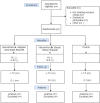Effect of vaccine reminder and tracker bracelets on routine childhood immunization coverage and timeliness in urban Pakistan: protocol for a randomized controlled trial
- PMID: 31666039
- PMCID: PMC6820929
- DOI: 10.1186/s12889-019-7667-3
Effect of vaccine reminder and tracker bracelets on routine childhood immunization coverage and timeliness in urban Pakistan: protocol for a randomized controlled trial
Abstract
Background: Inability to track children's vaccination history coupled with parents' lack of awareness of vaccination due dates compounds the problem of low immunization coverage and timeliness in developing countries. Traditional Reminder/Recall (RR) interventions such as paper-based immunization cards or mHealth based platforms do not yield optimal results in resource-constrained settings. There is thus a need for a low-cost intervention that can simultaneously stimulate demand and track immunization history to help reduce drop-outs and improve immunization coverage and timeliness. The objective of this study is to evaluate the impact of low-cost vaccine reminder and tracker bracelets for improving routine childhood immunization coverage and timeliness in Pakistani children under 2 years of age.
Methods: The study is an individually randomized, three-arm parallel Randomized Controlled Trial with two intervention groups and one control group. Infants in the two intervention groups will be given two different types of silicone bracelets at the time of recruitment, while infants in the control group will not receive any intervention. The two types of bracelets consist of symbols and/or numbers to denote the EPI vaccination schedule and each time the child will come for vaccination, the study staff will perforate a hole in the appropriate symbol to denote vaccine administration. Therefore, by looking at the bracelet, caregivers will be able to see how many vaccines have been received. Our primary outcome measure is the increase in coverage and timeliness of Pentavalent-3/PCV-3/Polio-3 and Measles-1 vaccine in the intervention versus control groups. A total of 1446 participants will be recruited from 4 Expanded Program on Immunization (EPI) centers in Landhi Town, Karachi. Each enrolled child will be followed up till the Measles-1 vaccine is administered, or till eleven months have elapsed since enrolment.
Discussion: Participant recruitment commenced on July 19, 2017, and was completed on October 10, 2017. Proposed duration of the study is 18 months and expected end date is December 1, 2018. This study constitutes one of the first attempts to rigorously evaluate an innovative, low-cost vaccine reminder bracelet.
Trial registration: ClinicalTrials.gov NCT03310762 . Retrospectively Registered on October 16, 2017.
Keywords: Immunization coverage and timeliness; Immunization reminders; Silicone bracelets.
Conflict of interest statement
The authors declare that they have no competing interests.
Figures
Similar articles
-
Effect of vaccine reminder and tracker bracelets on routine childhood immunization coverage and timeliness in urban Pakistan (2017-18): a randomized controlled trial.BMC Public Health. 2020 Jul 11;20(1):1086. doi: 10.1186/s12889-020-09088-4. BMC Public Health. 2020. PMID: 32652969 Free PMC article. Clinical Trial.
-
The Mobile Solutions for Immunization (M-SIMU) Trial: A Protocol for a Cluster Randomized Controlled Trial That Assesses the Impact of Mobile Phone Delivered Reminders and Travel Subsidies to Improve Childhood Immunization Coverage Rates and Timeliness in Western Kenya.JMIR Res Protoc. 2016 May 17;5(2):e72. doi: 10.2196/resprot.5030. JMIR Res Protoc. 2016. PMID: 27189422 Free PMC article.
-
Feasibility of implementing a cellphone-based reminder/recall strategy to improve childhood routine immunization in a low-resource setting: a descriptive report.BMC Health Serv Res. 2017 Dec 4;17(Suppl 2):703. doi: 10.1186/s12913-017-2639-8. BMC Health Serv Res. 2017. PMID: 29219093 Free PMC article. Clinical Trial.
-
Two-dose measles vaccination schedules.Bull World Health Organ. 1993;71(3-4):421-8. Bull World Health Organ. 1993. PMID: 8324862 Free PMC article. Review.
-
Pakistan's expanded programme on immunization: an overview in the context of polio eradication and strategies for improving coverage.Vaccine. 2013 Jul 18;31(33):3313-9. doi: 10.1016/j.vaccine.2013.05.015. Epub 2013 May 22. Vaccine. 2013. PMID: 23707167 Review.
Cited by
-
Changes in Adherence and Viral Load Suppression Among People with HIV in Manila: Outcomes of the Philippines Connect for Life Study.AIDS Behav. 2024 Mar;28(3):837-853. doi: 10.1007/s10461-023-04190-1. Epub 2023 Oct 4. AIDS Behav. 2024. PMID: 37794284
-
Improving the timeliness and completeness of childhood vaccination through color-coded bracelets: a pilot study among Fulani tribe populations in Nigeria.J Public Health Afr. 2023 May 3;14(5):2079. doi: 10.4081/jphia.2023.2079. eCollection 2023 Apr 30. J Public Health Afr. 2023. PMID: 37441119 Free PMC article.
-
Approaches to Reach Trustworthy Patient Education: A Narrative Review.Healthcare (Basel). 2024 Nov 21;12(23):2322. doi: 10.3390/healthcare12232322. Healthcare (Basel). 2024. PMID: 39684944 Free PMC article. Review.
References
-
- World Health Organization. World Immunization Week 2016: Immunization game-changers should be the norm worldwide. 2016 [cited 2017 2017-11-22]; Available from: http://www.who.int/mediacentre/news/releases/2016/world-immunization-wee...
-
- World Health Organization . Weekly epidemiological record: Global routine vaccination coverage, 2016. 2017. pp. 701–716.
-
- World Health Organization. Immunization coverage - DTP3 at district level. 2016 [cited 2017 2017-11-21]; Available from: http://apps.who.int/gho/data/view.other.immu-admin2-dtp3?lang=en)
MeSH terms
Substances
Associated data
Grants and funding
LinkOut - more resources
Full Text Sources
Medical




